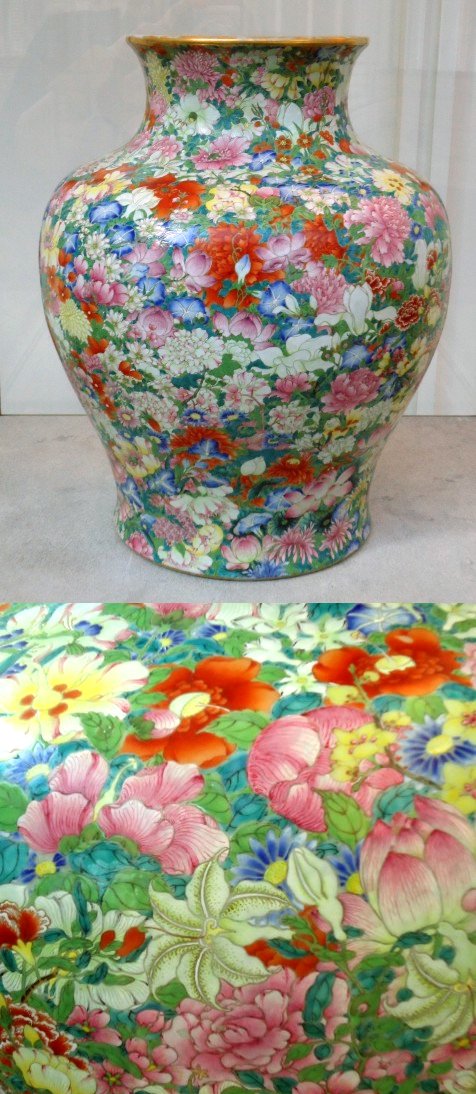 border="0" />
border="0" />
Mille fleur decoration of the Qianlong period, Musée Guimet, Paris.
Picture curtesy of Michaela Russell, Gotheborg Discussion Board.
The Mille Fleur (Fr.) decoration, meaning the "thousand flowers design" first appears in the late Yongzheng period becoming extremely popular in the Qianlong and was carried on throughout the subsequent Jiaqing and Daoguang periods, usually on a gilt ground. The design symbolized "all the flowers bestow their blessings". During the early period, the flowers are usually smaller and the design more dense than during the later Guangxu and Republic periods.
The dense millefleurs design features naturalistic blossoming peonies, chrysanthemums, hibiscus, morning glories, roses, lotus flowers, daisies, lilies and pinks amidst an abundance of foliage, the mouth rims with gilt bands, the bases and interiors often turquoise-enameled on older pieces. The decoration was used to decorate a small group of wares, and while vases number among them, the design is more often seen on smaller pieces as bowls and cups.
The style got popular again during the Guangxu period and could then also appear with black backgrounds. The sizes of the pieces are now generally larger. The mille fleur pieces produced during the Guangxu reign and after are unusual but not really rare. The palette was employed on many export items then and later of various qualities and occurs up until today.
During the Republic there were some attempts to copy the denser florals (no ground colour usually, just foliage) of the Qianlong period. During the 1920s or so, several apochcryphal reign marks were used, Qianlong mainly, but Kangxi and Yongzheng were popular too. So the copier copies the copier.
A large Qianlong baluster vase (48 cm. high) with this decoration is in the Musée Guimet, Paris, illustrated in Oriental Ceramics, The World's Great Collections, Kondasha Series, Japan, 1981, vol. 7, pl. 52; and a slightly smaller compressed pear-shaped vase is in the Asian Art Museum of San Francisco, illustrated by He Li, Chinese Ceramics: A New Comprehensive Survey, New York, 1996, no. 665. Jiaqing 'millefleurs' pear-shaped vases have also been recorded, one in the Shanghai Museum, illustrated in Chugoku Toji Zensh, vol. 21, Jingdezhen Polychrome Ceramics, Japan, 1981, pl. 144.
A